
Discover the Palace of Serbia: A Symbol of National Heritage
Explore the Palace of Serbia, a stunning architectural gem and a vital part of Serbia's political landscape, nestled in the heart of New Belgrade.
The Palace of Serbia, located in New Belgrade, is an architectural marvel and a symbol of the nation’s political history. This government office building showcases the beauty of Serbian design and offers insights into the country’s governance.
A brief summary to Palace of Serbia
- Bulevar Mihajla Pupina 2, Belgrade, New Belgrade, RS
- +381113114240
Local tips
- Visit early in the morning for quieter surroundings and beautiful light for photography.
- Check out nearby parks for a relaxing break after your visit.
- Enjoy a coffee at a local cafe and observe the daily hustle and bustle of Belgrade.
- While inside is not accessible to the public, the exterior offers ample opportunities for great photos.
Getting There
-
Car
If you are traveling by car from any location in Južna Srbija, you would typically take the E75 highway towards Belgrade. Make sure to follow the signs directing you to 'Beograd'. After approximately 2.5 to 3 hours of driving (depending on your starting point), you will enter New Belgrade. Look for 'Bulevar Mihajla Pupina' road. The Palace of Serbia is located at Bulevar Mihajla Pupina 2, which will be on your right side. There is limited parking available nearby, so plan accordingly.
-
Public Transportation
To use public transportation, first, make your way to the nearest bus or train station in Južna Srbija. Buses and trains to Belgrade are frequent. You will want to take a bus or train to the main bus/train station in Belgrade, known as 'Autobuska Stanica Beograd' or 'Beograd Glavna Železnička Stanica'. Upon arrival in Belgrade, you can take tram line 7 or bus line 15 from the station to the 'Bulevar Mihajla Pupina' stop. The Palace of Serbia is a short walk from the tram/bus stop.
-
Taxi or Ride-Sharing
If you prefer a more direct route and convenience, consider taking a taxi or using a ride-sharing service like CarGo or Bolt, which are popular in Serbia. Simply provide the driver with the address: Bulevar Mihajla Pupina 2, Beograd. This option is particularly useful if you are traveling in a group or have luggage. The cost will vary depending on your starting location, but expect to pay more than public transportation.
Discover more about Palace of Serbia
Iconic landmarks you can’t miss
Palace of Serbia
0.0 km
Explore the Palace of Serbia, a stunning government building in Belgrade that embodies the nation's rich history and modern aspirations.
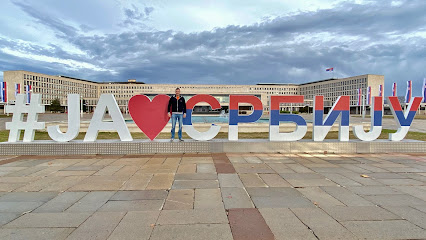
Office for Kosovo and Metohija
0.1 km
Discover the political heart of Serbia at the Office for Kosovo and Metohija, where history and contemporary issues intersect in Belgrade.

Eternal Flame
0.6 km
Discover the poignant beauty of the Eternal Flame in New Belgrade, a memorial honoring World War II heroes amidst serene park surroundings.

The Zemun Train Station Monument
1.5 km
Explore the rich history of Belgrade at the Zemun Train Station Monument, a stunning architectural landmark steeped in cultural significance.

Outer Sava Gate
1.6 km
Explore the Outer Sava Gate, a stunning historical landmark in Belgrade that beautifully encapsulates the city's rich cultural heritage and architectural splendor.

Monument to the Victims of the Sajmište Concentration Camp
1.7 km
Explore the Monument to the Victims of the Sajmište Concentration Camp in Belgrade, a poignant reminder of history and resilience amidst urban tranquility.

Roman well
1.7 km
Explore the historic Roman Well in Belgrade, a captivating site that reveals the city's ancient engineering marvels and rich cultural heritage.

Japanese Fountain
1.7 km
Discover the tranquil beauty of the Japanese Fountain in Belgrade's historic Stari Grad, a serene oasis perfect for relaxation and cultural exploration.

Бункер на Београдској тврђави
1.7 km
Explore the historic Belgrade Fortress, where ancient history meets stunning views of the Sava and Danube rivers in the heart of Serbia.

Спомен-обележје турске опсаде Београда 1456. године
1.8 km
Explore the historic Belgrade Fortress, a captivating landmark with stunning views, rich history, and cultural significance in the heart of Serbia.

Nebojša Tower
1.8 km
Nebojša Tower in Belgrade: A historic fortress revealing the rich tapestry of Serbian heritage and stunning river views.

Torture Museum
1.8 km
Discover the haunting history of humanity at the Torture Museum in Belgrade, where dark tales and chilling artifacts await you.

Charles VI Gate
1.8 km
Explore the stunning Charles VI Gate, a historical landmark in Belgrade, where rich history meets breathtaking architectural beauty.

Belgrade Fortress
1.8 km
Discover Belgrade Fortress, a historic gem overlooking the convergence of the Sava and Danube rivers, rich in history and stunning views.

Kalemegdan
1.9 km
Discover Kalemegdan, Belgrade's iconic fortress and park offering stunning views, historical landmarks, and vibrant cultural experiences in Serbia's capital.
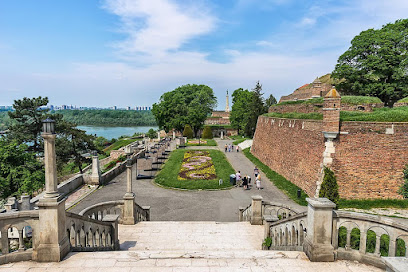
Unmissable attractions to see
Belgrade Arena
0.8 km
Discover the excitement of Belgrade Arena, a leading sports complex in Serbia, renowned for thrilling events and vibrant cultural experiences.
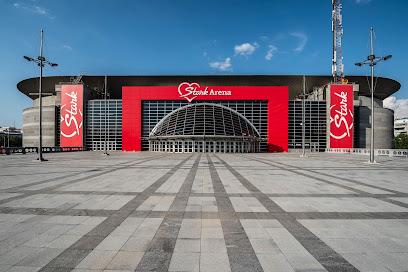
Ušće
0.9 km
Explore the lush landscapes and serene views of Ušće Park, a tranquil escape in the heart of New Belgrade, perfect for relaxation and recreation.

Chinese Cultural Center
0.9 km
Explore the vibrant Chinese Cultural Center in Belgrade, where tradition meets contemporary art, culture, and cuisine.

Kajak rekreacija Beograd - Kayak tours Belgrade
1.1 km
Experience the thrill of kayaking in Belgrade with Kajak Rekreacija, your adventure sports hub for unforgettable water tours.

Belgrade Adventure
1.1 km
Experience the thrill of adventure in Belgrade with guided tours and exciting outdoor activities at Belgrade Adventure.

Park Ušće
1.1 km
Explore the tranquil beauty of Park Ušće, a lush green oasis in Belgrade, perfect for relaxation and outdoor activities.

Ušće Park (Birding place)
1.2 km
Explore Ušće Park, a serene birdwatching haven in Belgrade, perfect for nature lovers and outdoor enthusiasts seeking tranquility.

Museum of contemporary art
1.2 km
Explore contemporary creativity at the Museum of Contemporary Art in Belgrade, showcasing modern artistic expressions and cultural dialogues.
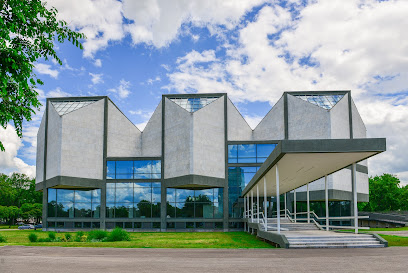
Great War Island
1.2 km
Explore Great War Island, a tranquil retreat near Belgrade, rich in biodiversity and steeped in fascinating military history.

Sava Center
1.3 km
Discover the Sava Center, a cultural and business hub in Belgrade, showcasing events, architecture, and vibrant city life along the Sava River.

Grand Casino Belgrade
1.3 km
Discover the ultimate gaming experience at Grand Casino Belgrade, where luxury meets excitement in the heart of Serbia's capital.

Nacionalna Klasa Beograd
1.3 km
Experience the rich flavors of Serbia at Nacionalna Klasa, Belgrade's premier destination for authentic Serbian cuisine in a warm and inviting atmosphere.

Big War Island
1.4 km
Explore the tranquil beauty and rich biodiversity of Big War Island, a serene nature preserve in the heart of Belgrade.

Zemun Riverside
1.5 km
Discover the tranquility and picturesque charm of Zemun Riverside, a perfect retreat along the Danube River in Belgrade.

Concrete Boat
1.5 km
Experience the unique blend of exquisite dining and cultural immersion at the Concrete Boat in Belgrade, a floating restaurant and museum.

Essential places to dine
Stara Koliba
0.3 km
Discover authentic Serbian cuisine at Stara Koliba – a delightful riverside restaurant serving fresh fish and traditional dishes in Belgrade.

Restoran Srem
0.7 km
Discover authentic Serbian flavors at Restoran Srem in New Belgrade—where grilled perfection meets warm hospitality.

Stari Žabar
0.9 km
Discover exquisite Serbian cuisine at Stari Žabar in Belgrade's Zemun district, where tradition meets modern dining excellence.

Gig Restaurant Belgrade
0.9 km
Discover the art of fine dining at Gig Restaurant Belgrade - where Asian meets European cuisine in a stylish setting.

Restoran Jerry
0.9 km
Experience the finest Serbian cuisine at Restoran Jerry in New Belgrade, where culinary artistry meets exceptional service.

Tavern Jakovljević
1.0 km
Experience authentic Serbian cuisine with stunning river views at Tavern Jakovljević in New Belgrade.

Prime Restaurant
1.3 km
Experience gourmet dining at Prime Restaurant in New Belgrade, where exquisite flavors meet exceptional service in an elegant setting.
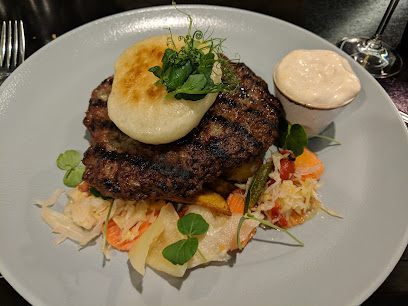
Splav Rесторан "Воденица"
1.6 km
Experience Belgrade's finest seafood at Splav Rесторан 'Воденица', where fresh flavors meet stunning riverside views.

Buena Vida Beograd
1.6 km
Experience authentic Mexican flavors at Buena Vida Beograd - where every dish is a celebration of culture and taste.

Ambar
1.6 km
Discover the essence of modern Serbian cuisine at Ambar in Belgrade—where tradition meets innovation in every delicious dish.

Toro Latin Gastro Bar
1.6 km
Experience the vibrant fusion of Latin American flavors at Toro Latin Gastro Bar in Belgrade – where every meal tells a story.

Comunale Caffe e Cucina
1.6 km
Discover exquisite flavors at Comunale Caffe e Cucina in Belgrade's Beton Hala - a top destination for food enthusiasts seeking culinary excellence.

Tomahawk
1.8 km
Experience culinary excellence at Tomahawk, Belgrade's top steakhouse offering premium cuts and an inviting atmosphere.

Radost Fina Kuhinjica
1.8 km
Discover the flavors of vegetarian cuisine at Radost Fina Kuhinjica in Belgrade - where every dish tells a story.
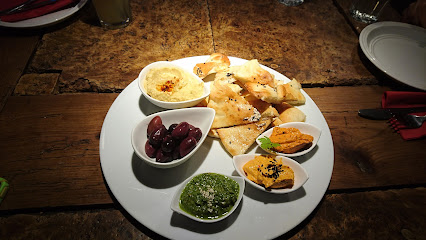
Kafana SFRJ
1.8 km
Experience authentic Serbian cuisine at Kafana SFRJ in Belgrade – where tradition meets flavor in a vibrant atmosphere.

Markets, malls and hidden boutiques
Ta Nana Organska Nana
0.7 km
Explore a botanical paradise at Ta Nana Organska Nana, a serene plant nursery offering diverse flora and expert gardening advice in a tranquil setting.

SERBIA ART
0.7 km
Explore the vibrant artistic culture of Serbia at Serbia Art, a unique souvenir store and hub for local artisans in Belgrade.

Gadget 4 Gift Novi Beograd
0.8 km
Explore Gadget 4 Gift in Novi Beograd for unique souvenirs and innovative gadgets that celebrate Serbian culture.

UŠĆE Shopping Center
0.8 km
Discover the ultimate shopping experience at UŠĆE Shopping Center, Belgrade's premier destination for fashion, dining, and entertainment.

Mercator center
1.0 km
Discover the Mercator Center: Belgrade's premier shopping destination with diverse shops, dining, and entertainment for every traveler.

Makadam Concept Store
1.9 km
Explore Belgrade's Makadam Concept Store for unique gifts, fashion accessories, and a cozy café experience amidst the city's vibrant culture.

Gradstor Design Hub
2.0 km
Discover the heart of Belgrade's fashion scene at Gradstor Design Hub, where unique clothing and local artistry come together in style.

Casual Shop - Кежуал бутик
2.1 km
Explore Casual Shop in Belgrade for trendy casual wear that combines comfort and style, perfect for every fashion enthusiast visiting the city.

Rajićeva Shopping Center
2.1 km
Discover the vibrant Rajićeva Shopping Center in Belgrade, where shopping, dining, and culture come together in a stylish setting.

World Fashion Medium
2.1 km
Explore the latest trends and timeless styles at World Fashion Medium, Belgrade's premier destination for fashion-forward clothing.

BUDISLAVA - BelgradeDesignHub
2.1 km
Explore Budislava, Belgrade's vibrant boutique hub showcasing local design and creativity in a warm and welcoming atmosphere.

DRAGANA OGNJENOVIĆ FASHION DESIGN SHOP
2.1 km
Explore the stylish offerings of Dragana Ognjenović Fashion Design Shop, a unique destination for fashion lovers in Belgrade's Stari Grad.

Pinko Boutique
2.1 km
Discover the latest trends in women's fashion at Pinko Boutique, Belgrade’s stylish destination for contemporary clothing and accessories.

KONCEPT 45
2.2 km
Discover contemporary fashion, stylish accessories, and exquisite jewelry at KONCEPT 45 in the heart of Belgrade.

Antikvarnica Antique art
2.2 km
Discover the charm of the past at Antikvarnica Antique Art, a hidden gem in Belgrade's historic district filled with unique treasures.

Essential bars & hidden hideouts
Svaštara Concept Bar
0.7 km
Experience the vibrant ambiance and cultural essence of Svaštara Concept Bar, a gem for food and drink lovers seeking authentic local flavors.

Gradska Kafana Beograd
1.3 km
Discover the vibrant nightlife at Gradska Kafana Beograd, a lively bar and restaurant offering a taste of local cuisine and entertainment.

Central Pub
1.5 km
Experience the vibrant atmosphere of Central Pub in New Belgrade, where delicious food and drinks meet a lively social scene.

The Black Turtle
1.9 km
Experience the heart of Belgrade at The Black Turtle, a brewpub offering unique craft beers and a lively atmosphere perfect for socializing.

Ćevap Bar ''Crni Đorđe''
1.9 km
Discover the true taste of Serbian barbecue at Ćevap Bar ''Crni Đorđe'', where culinary tradition meets a vibrant atmosphere in Belgrade.

Tranzit Bar
1.9 km
Dive into Belgrade's nightlife at Tranzit Bar, a lively bar and disco club famous for its vibrant atmosphere and infectious music.
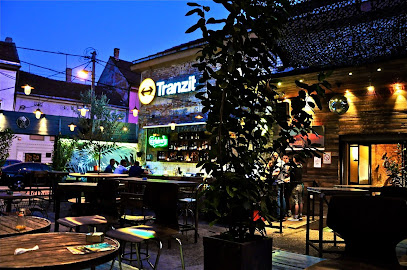
Аутсајдер / Autsajder
2.0 km
Discover Autsajder in Belgrade: a cozy café bar blending cocktails, wines, and live music for a perfect local experience.

Witch Bar
2.0 km
Discover the enchanting ambiance and exquisite cocktails at Witch Bar, a hidden gem in the heart of Belgrade's nightlife.

Boho Bar
2.0 km
Discover the stylish Boho Bar in Belgrade, where artisanal cocktails meet stunning views in a vibrant atmosphere.

Vinoteka Savamala Bar & Shop
2.0 km
Experience the essence of Belgrade’s wine culture at Vinoteka Savamala, where every glass tells a unique story.
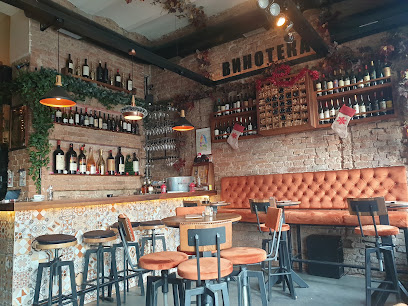
Funk & Soul Pub
2.2 km
Discover Belgrade's vibrant nightlife at Funk & Soul Pub, where great drinks and lively music create unforgettable experiences.

Druid bar
2.2 km
Experience Belgrade's vibrant nightlife at Druid Bar, where expertly crafted cocktails and a unique ambiance await you.

Belgrade Cocktail Club
2.2 km
Experience the art of mixology at Belgrade Cocktail Club, where every cocktail is a masterpiece waiting to be savored.

Pab na vodi
2.2 km
Experience the vibrant atmosphere and stunning river views at Pab na vodi, a charming bar in the heart of Belgrade.

in Seoul
2.2 km
Discover the vibrant nightlife in Belgrade at this charming bar, where local drinks and a lively atmosphere await tourists and locals alike.




